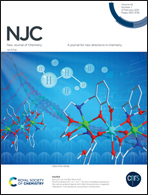Discovery of triazolyl thalidomide derivatives as anti-fibrosis agents†
Abstract
Fibrosis with excessive accumulation of extracellular matrix (ECM) often causes progressive organ dysfunction and results in many inflammatory and metabolic diseases, including systemic sclerosis, pulmonary fibrosis, advanced liver disease and advanced kidney disease. The store-operated calcium entry (SOCE) pathway and the related signaling pathway were both found to be the important routes for fibrogenesis. Our aim in this study was to discover novel compounds to inhibit fibrogenesis. A number of triazolyl thalidomide derivatives were synthesized and evaluated for their anti-fibrosis activities. Compounds 7b–e, 8c–d, 10a–b and 10e inhibited intracellular Ca2+ activation and showed no cytotoxicity. Among them, 6-{4-[(3-(1,3-dioxoisoindolin-2-yl)-2,6-dioxopiperidin-1-yl)methyl]-1H-1,2,3-triazol-1-yl}hexanoic acid (10e) with the most potent inhibitory effect was chosen for further examination. The results revealed that compound 10e, a SOCE inhibitor, reversed the migratory ability of TGF-β1-induced myofibroblasts, dedifferentiated myofibroblasts to fibroblasts due to cytoskeleton remodeling, and restrained myofibroblast activation by targeting Orai1 and TGF-β1/SMAD2/3 signaling pathways. The in silico study indicated that compound 10e, with the appropriate lipophilic carbon chain and carboxylic acid, showed a good drug-likeness model score. Conclusively, the SOCE inhibitor, compound 10e, is used as a promising lead compound for the development of a new treatment for fibrosis.



 Please wait while we load your content...
Please wait while we load your content...